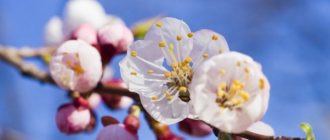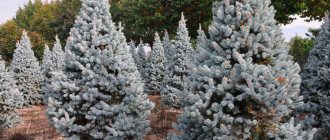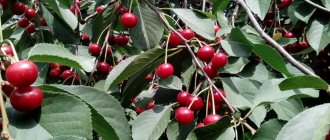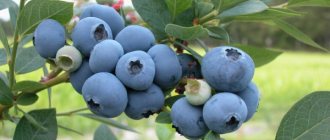Judas tree is the informal name for the Cercis plant.
This unusual name has biblical roots. There is a whole legend about the Judas tree associated with the death of the Apostle Judas, who betrayed Jesus Christ. According to this legend, Judas, tormented by pangs of conscience, hanged himself from a tree.
Not far from this place grew a beautiful plant that bloomed with snow-white flowers. Seeing the torment and death of the unfortunate man, the tree took pity on him. And he became so sad that his snow-white flowers turned purple. And this is no coincidence, because it is the purple color that personifies grief and melancholy in many cultures and religions. And the plant itself began to be called the Judas tree.
There is another version of the origin of such an unusual name. According to her, this plant was very common in ancient Judea, and therefore was called the Judas tree.
Botanical description
The shrub is widespread in Asia, China and the Mediterranean - the plant is very heat-loving. There are about 9 species, among them there are frost-resistant hybrids. Tree of Judah, Judas tree, Jewish tree - this is what the bush is called.
According to legend, Judas was crucified on this tree after he betrayed Christ. And since then the Jewish tree has bloomed with red-violet flowers and has absolutely no smell.
|
Development and disease
Shoots from seeds sown in autumn appear after the snow melts. During spring and summer they stretch 40–50 cm and die in frosts. Dormant buds are preserved in the soil on the root collars, from which stronger shoots up to 80–100 cm in height grow the next year. During cold weather, they also partially or completely freeze over. With the onset of warmth, the above-ground part is restored. Over the course of 3–4 years, the roots of the scarlet tree grow inward and to the sides by 2–3 m. Skeletal woody shoots grow more slowly and are formed after the root system is fully formed. Mature bushes tolerate winter better; thin first-year side shoots can freeze.
Mature trees develop cracks in their trunks after severe frosts. To prevent this, the bushes must be covered for the winter by first tying the branches.
Diseases and pests of Cercis are almost harmless. Sometimes aphids attack the foliage. To get rid of it, the crown is sprayed with insecticides. Severely affected shoots are cut off.
Planting Cercis in open ground
The young plant is planted immediately in a permanent place, since the roots of Cercis are very delicate.
The most favorable time for planting in open ground is spring, so that the plant has time to take root:
Selecting a location
| |
Landing
|
Growing Cercis on the site
In order for the tree to be beautiful, you need to choose the right planting site and follow simple rules of care.
Selecting soil and planting location
The best site is the one that is well heated by the sun. Also, the area where the tree will grow should be away from drafts. This is very important, since frosty winds can negatively affect the branches.
The plant loves a substrate that allows water to pass through well. The soil must also have lime in its composition and drainage. If the site has clay soil, then you should add a little sand to it. This will prevent water from stagnating.
Cercis canadensis is most often grown in the Moscow region. This is due to the fact that it is not afraid of frost.
Plant pruning
This procedure is carried out in the fall on trees that are 4 years old. The shoots are removed by 1/3, and the cut areas are treated with a special agent.
It is also necessary to trim off side branches that have the wrong direction and basal shoots.
In spring, pruning consists of removing shoots damaged by frost.
Possible pests
Cercis is resistant to various diseases and insects. Very rarely, a tree can be affected by aphids. In this case, all parts are treated with Confidor, Aktara or other similar preparations.
Proper wintering
Before the onset of frost, the branches must be carefully tied and covered with burlap. The material is secured at the base with a thick thread.
It is also necessary to pay attention to the soil near the trunk. It is mulched with sawdust or fallen spruce needles.
Reviews from gardeners
loo1:
“Sergey, in general it is growing quickly, this is my 2nd year, I took it very small, it has grown 2 times, it has also bloomed for the 2nd year, but this year there are more flowers. So, I think that in a year or two yours will bloom. But it will bloom profusely only in adulthood. It still tries to grow as a bush, it produces shoots from the roots, but I remove them so that it becomes a tree. In our region, the temperature in winter varies from -15-20 degrees, and it was -27-28 degrees, but only for about a week. And nothing happened to him. Not far from me, a cercis tree grows 3 m high.”
Source forum-flower.ru
Irina:
“I have 2 cercis growing. One tree and one grows as a bush. The tree bloomed this spring. But the flowering is not very abundant yet. But I just want to buy a scarlet. The leaves of the crimson plant are located oppositely. This means that the seedling can be immediately distinguished from the cercis. I’ve never covered Cercis and it doesn’t freeze at all... I’ll try to look for a photo of my tree.”
Source forum.cvetnichki.com.ua
Administrator:
“While vacationing in Miskhor, I noticed this interesting tree that was self-seeding throughout the entire territory of the sanatorium. Indescribable beauty! The large, round leaves have distinct veins. The flowers are located along the entire length of the shoot, pink in color, slightly similar to pea flowers. I collected several pods with already ripened seeds and tried to germinate them, but nothing came of this venture. And you? I know that some gardeners spend the winter even in Kharkov, although they form it in the form of a bush and not a tree... And also, a question for the experts: Cercis and Purple, are they the same thing or not?”
Source forum.cvetnichki.com.ua
Propagation of Cercis tree by cuttings
It is necessary to separate planting material only from strong shoots. It is better to take cuttings from branches that are 2-3 years old. Each of them must have at least two healthy buds.
There is no need to process the cutting; it is immediately dropped into the chosen place. The planting material is deepened by 15 cm and placed at an angle.
The procedure is carried out in late autumn. If everything is done correctly, then before the onset of cold weather the cuttings will have time to take root well and new shoots will appear.
If you follow all the rules described above, the Cercis tree will certainly delight you with abundant and colorful flowering. You can admire the magnificent inflorescences three years after planting.
Cercissus europaea
This is a southern species that is not frost-resistant, so it is widespread only on the Black Sea coast. The flowers are quite large (up to 2.5 cm). They appear as if from the bark that covers the branches. There is a white-flowered form of this species.
In landscape design, cercis (or Judas tree) combines perfectly with bird cherry, bean tree, conifers, cherries, and decorative flowering shrubs.
Properties of cercis and its use
Despite the lack of scent in the flowers, Cercis is considered a good honey plant and attracts bees to the area. Honey obtained from this plant is considered rare; it has a pleasant taste and aroma, and also benefits the body. The buds of the European species can be used as a seasoning, and the beneficial substances in the leaves of Cercis allow it to be used as a remedy against tuberculosis: it contains beneficial flavonoids. The bark of the plant is also used by Chinese healers as an antibacterial agent in the treatment of wounds.
Fruit trees and shrubs Garden: trees and shrubs
Cercis care
The root system of Cercis develops very strongly, going up to 2 m deep and up to 8 m wide. Such an extensive feeding zone saturates the tree with moisture and necessary substances, so Cercis will not need regular watering and fertilizing. The plant should be cared for only during periods of prolonged heat and drought.
As a rule, with proper care, Cercis practically does not get sick and is not affected by pests. Only occasionally can aphids settle on the plantings, which are eliminated with insecticides. In spring, the tree trunk should be whitened. Before flowering begins, the crown of the plant can be sprayed with a solution of Bordeaux mixture in a weak concentration - this will serve as the prevention of anthracnose. The root area of young plants should be mulched for the winter.
If necessary, the cercis can be trimmed. The crown is formed in the autumn, shortening the shoots by no more than a third. Usually, young (3-5 year old) plants are formed, and then limited to only sanitary pruning.
How to plant a Judas tree
Those who want to plant a Judas tree in their dacha should know that the best way to do this is to grow cercis from seeds. Cuttings do not take root well in the climatic conditions of the Russian Central Zone, do not adapt well to weather conditions and often die. Seeds can be purchased at nurseries or ordered online. When ordering or purchasing seeds, you should use the scientific name of the plant “Cercis canadensis”, because the common name “Judas tree” is not popular in Russia .
In order for the seeds to germinate faster, they must be soaked before planting. You can also resort to an effective method of seed stratification. To prevent fungal infections, many gardeners also treat Cercis canadensis seeds with fungicide solutions.
Seeds are sown in well-loosened soil. Soon the first shoots appear. The plant quickly develops a root system. At first, the cercis actively forms a large number of lateral shoots right on the surface of the earth, but then they gradually die off and a neat bush is formed. Young plants look impressive; they are often planted around the perimeter of the site as a hedge.
Where is it used?
This shrub is used for decorative purposes. Used in carpentry work. Its buds are used in cooking to make spicy seasonings. This tree is loved by beekeepers. Many of them plant this shrub on their site in order to attract bees.
Insects really like the bright shade of flowers. Honey, which is then collected after these bees, has many beneficial properties:
- Relieves inflammation.
- Kills bacteria.
- Treats lung diseases.
- Improves digestion.
History of the name
When domestic gardeners are asked what a Judas tree is, many answer as follows: “This is the aspen on which Judas hanged himself.” However, this is generally accepted only in Russia. In Western Europe, the name “Judas tree” (in English sounds like “Judah's Tree”) refers specifically to cercis. There are two versions regarding the origin of this interesting name. The first version claims that cercis was one of the most common trees in ancient Judea (in the territory of modern Israel and Palestine), hence the name “Judaea”).
However, there is another version of this unusual name. It dates back to biblical times. The Gospel says that one of the apostles - the first disciples of Jesus Christ - was Judas. Unlike other disciples of Christ, he did not have sincere faith in him. Judas differed from his comrades in such negative character traits as:
- Selfishness;
- Falsehood;
- Passion for profit;
- Readiness for meanness and betrayal.
Subsequently, the name “Judas” became a household name , and now this is the name given to every person who is ready to commit meanness for the sake of enrichment. When Jesus Christ dined with his disciples for the last time, Judas went and handed him over to the authorities. For this he received thirty silver coins. However, Judas soon began to suffer from pangs of conscience. He realized that he had betrayed his beloved teacher in vain, and realized that he was to blame for his earthly death. Judas was no longer happy about the money he received, because everyone had turned their backs on him.
Tormented by grief and pangs of conscience, he went wherever his eyes led him, came to the grove and hanged himself on a tree. Nearby grew a wonderful tree with snow-white flowers (this was the cercis).
When the tree saw what happened to Judas , the delicate flowers took pity on this unfortunate sinner and felt compassion for him. The beautiful tree was so upset by the inglorious death of Judas that the snow-white flowers turned purple. The color violet is traditionally considered the color of grief and sadness in many countries. This is how cercis appeared - a plant strewn with pink, lilac or violet flowers.
Subspecies variegated in the photo
Serissa variegata is one of the subspecies of Japanese serissa, differing from the main variety in the unusual color of its leaves.
The edges of the leaf blades are bright green, and closer to the center the shade becomes paler. This is due to the presence of chlorophyll-free cells, characteristic of all variegated plants.
Another distinctive feature of Serissa variegata is its increased care requirements, which is also characteristic of all variegata plants.
How to care
In order not to experience problems in caring for the plant, it needs to be provided with comfortable conditions. The bush itself is very whimsical. It only needs watering during periods when there is severe drought. It is also advisable to feed very rarely; this should be done once a year.
The plant does not tolerate cold weather, so it needs to be insulated in winter. young shrubs need to be pruned often, namely, young shoots must be removed, because they do not form a beautiful crown. You also need to remember that the plant has a very developed root system, so an adult shrub cannot be replanted.
You also need to frequently loosen the soil around the plants and remove weeds. The branches of the bush are very thin and delicate, so they can break from any gusts of wind; they need support.
Beneficial features
Doctors and biologists say that cercis leaves contain flavonoids - substances that have antibacterial and anti-inflammatory effects. Bioflavonoids, which are found in the leaves of Cercis, kill Koch's bacillus (a microorganism that is considered the causative agent of tuberculosis) and promote healing from pulmonary tuberculosis and bone tuberculosis.
The healing properties of cercis were also known in Ancient China. The Chinese used the bark of the plant for external use. Local healers believed that Cercis bark had an antibacterial effect, relieved inflammation and disinfected wounds. The bark of the plant, ground and ground into powder, was applied to open wounds, abscesses and ulcers. It was believed that this promotes rapid healing of the wound surface.
Features of the tree
Cercis has heart-shaped, slightly rounded leaves. They are green on top, smooth, and the underside is bluish. Young, newly emerged leaves have a reddish tint, which changes to light yellow in the fall. First, flowers appear on the tree, and only then leaves. The flowers remain on the tree for twenty days, by which time the leaves have already opened. Flowers of extraordinary beauty are delicate and can be painted in light lilac or a more saturated shade. They have a standard shape for legumes.
The Judas tree, the photo of which is presented in this article, has a fruit - a brownish flat bean about 10 cm long. They stay on the tree for up to two years.
Care and reproduction
Caring for a Judas tree is easy. It is necessary to loosen the tree trunks and water the plants in a timely manner. Individuals are especially demanding of moisture in the first 3–4 years of life; at this time, the roots are not yet sufficiently formed and cannot independently obtain moisture from great depths. In spring and summer, 2 buckets of water should be poured under each bush 1-2 times a week. It must be settled or slightly heated to 20°C. Tree trunk circles should be mulched with humus or peat.
The scarlet plant does not need to be fed frequently. In the spring, before the start of active growing season, you can add a small amount of rotted manure or other organic matter. If there is insufficient flowering, the bushes are fertilized once with phosphorus and potassium compounds.
In the spring, you need to carry out sanitary pruning, i.e. remove dried and frozen shoots . Formative haircuts begin at 4–5 years of age. Every year they get rid of root branches and shorten growing shoots. It is recommended to cut no more than ¼ of the crown at a time.
Purple plant is propagated by cuttings. The material is taken from plants that are 3 years old. The shoots to be cut should be about 30 cm long, strong, healthy, and contain several buds. Before planting, the cuttings are treated with a phytohormone and placed immediately in a permanent place in loose, moist soil to a depth of 10–12 cm. Cuttings are carried out in August. Before winter, the shoots have time to take root.











